Charter Arms was founded in 1964 by Doug McClenahan, who drew on his experience as a gun designer with Colt, High Standard, and Sturm Ruger to design an all-new double-action revolver. The Charter Arms “Undercover” was (and remains) a small-frame five-shot 38 Special revolver featuring a number of innovations: the frames were solid (built without a side plate) for increased strength; the lock work was simplified, with fewer moving parts aiding in reliability as well as cost of manufacture; and the Charter Arms design included their patented “transfer bar” safety system, allowing the revolver to be safely carried with a loaded chamber under the hammer. A transfer bar safety mechanism was used by Iver Johnson in the opening decades of the 20th Century, but the Charter Arms design of 1964 was new and innovative, has since been adopted by many revolver makers, and is the type we are familiar with today.
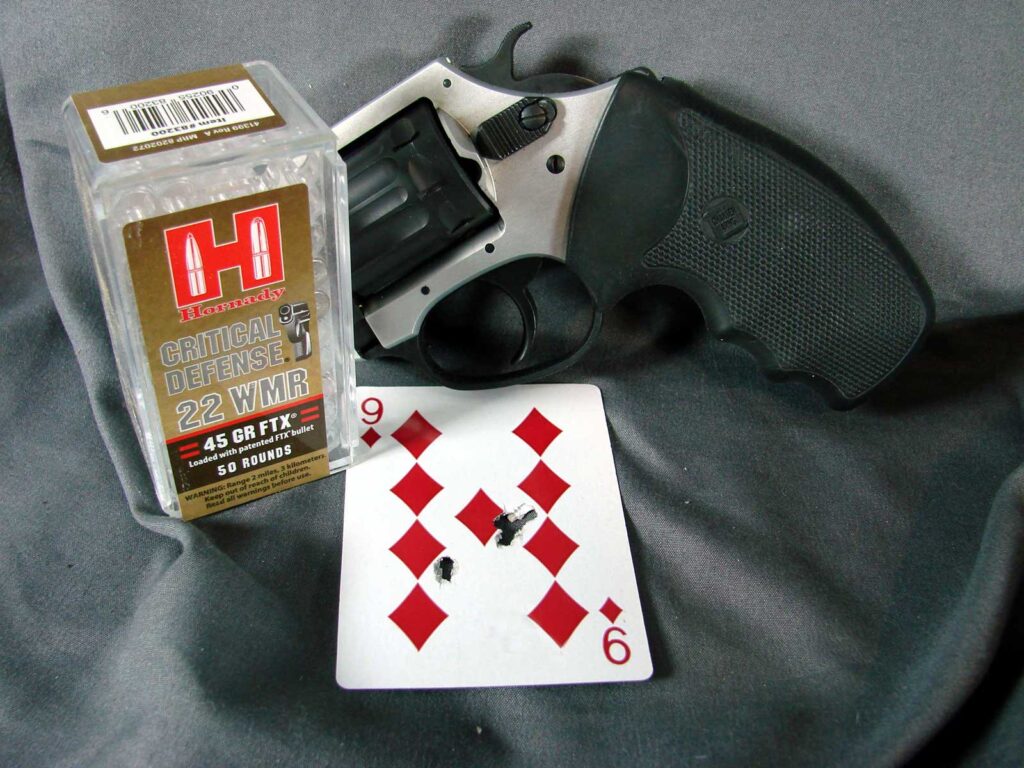
In 1967, McClenahan’s close friend David Ecker became an equal partner in Charter Arms. McClenahan retired in 1978, selling his part of the company to Ecker, and in 1984 Ecker’s son, Nick Ecker, signed on as part owner of Charter Arms. The company was sold to investors about 1988, becoming known as “Charco”, and quality control was sacrificed in the name of short-term profit until Charco closed its doors in 1998. Nick Ecker acquired the company in 2000, renaming it “Charter 2000” and working hard and smart to restore Charter’s reputation for high quality at reasonable prices. Today, once again known as Charter Arms, Nick Ecker’s company is a leader in firearms manufacturing technology, and today’s Charter Arms products offer greatly improved mechanics and superior fit and finish to anything the company has offered before, all while keeping prices affordable for the average shooter. Thanks to Nick Ecker’s leadership and vision, Charter Arms is on the cutting edge of modern manufacturing technology, and the questionable quality of revolvers made under the Charco brand is firmly in the past where it belongs.
The initial success of the Undercover from 1964 forward led to the introduction of a 22 model, the “Pocket Target” in 1970, which was renamed the “Pathfinder” late that year. Initially a target-sighted, all-steel, 22 Long Rifle revolver, the Pathfinder has evolved over the years into a variety of models, and is currently offered with an aluminum frame in a variety of finish combinations in either 22 Long Rifle (or 22 LR, which also accommodates 22 Long, 22 Short, and 22 CB Caps) or 22 Magnum (or 22 WMR / 22 Winchester Magnum Rimfire). Current barrel lengths run from 4.2 inches in the adjustable-sighted Target Pathfinder models down to 2 inches in the fixed-sighted Pathfinder Lite models.
A model of the 2″ fixed-sighted Pathfinder Lite is the subject of this article: the model #52329 Eight-Shot 22 Magnum in Black/Anodized finish.
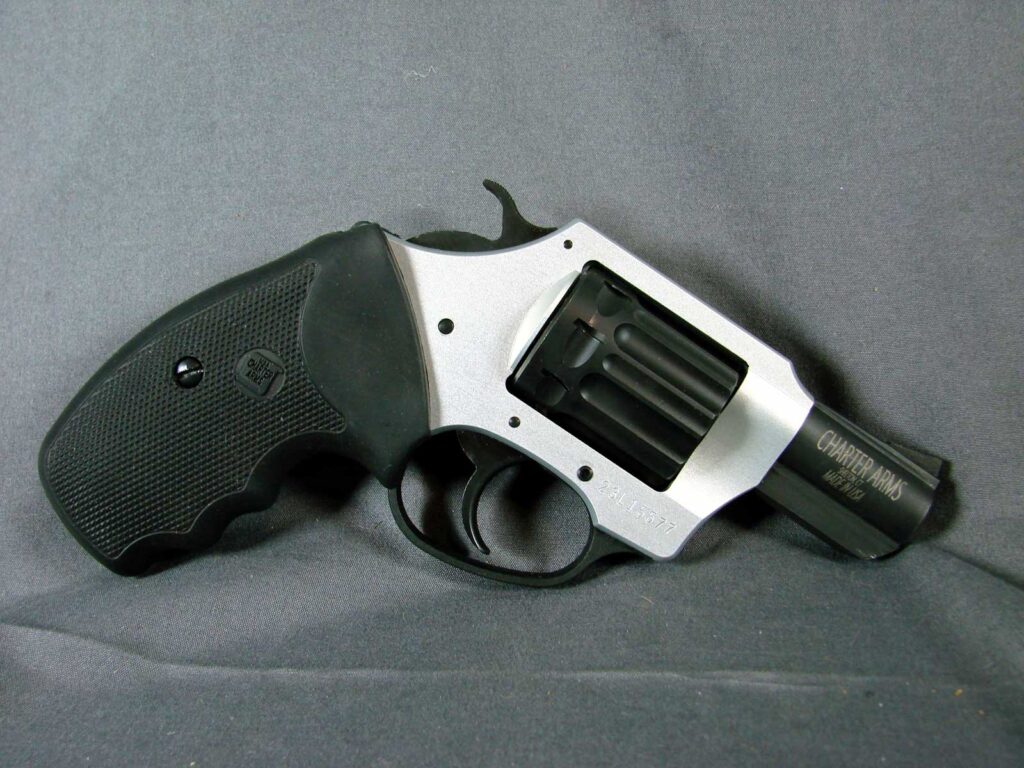
Charter Arms “Pathfinder Lite” 22 Magnum
The first obvious attribute of the Pathfinder Lite is the model’s namesake: its very light overall weight. Charter makes many models, in several calibers, with lightweight aluminum frames, and they have become quite good at it. The Pathfinder Lite weighs a scant 16 ounces, so it can be easily carried on one’s person all day long without becoming burdensome at all; in fact, one would scarcely know it is there. This is a wonderful attribute for carrying a revolver, whether the purpose is for small-game hunting, general woods-bumming, as a truck / tractor gun, or for serious self-defensive use.
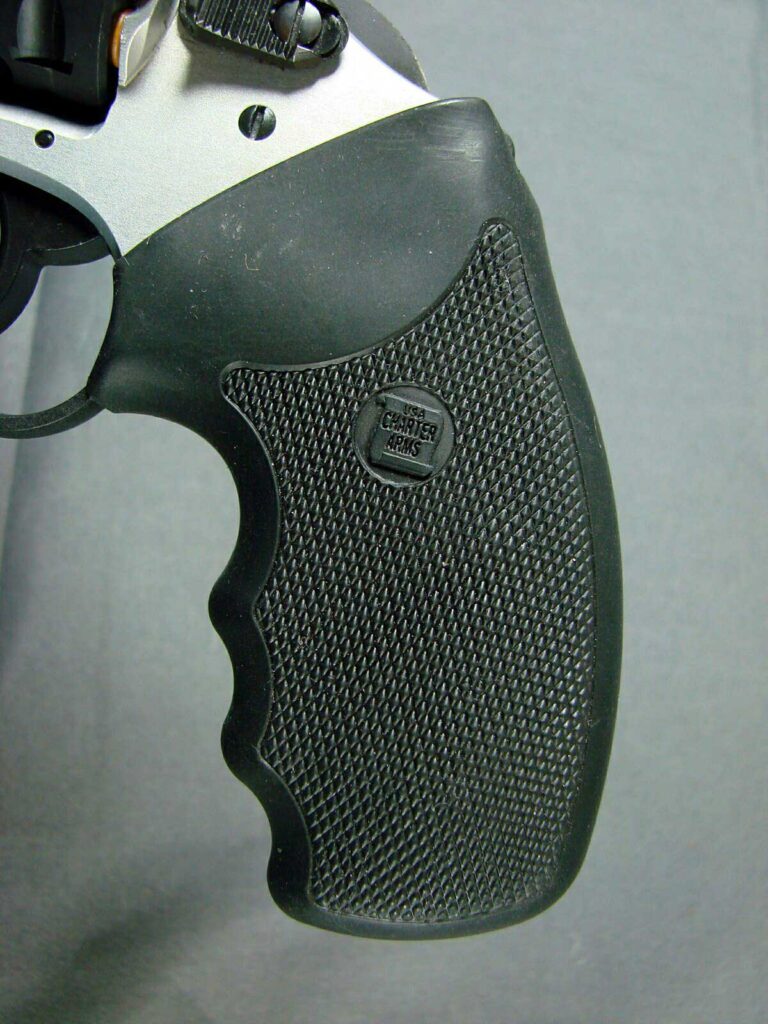
Full-sized checkered soft rubber grips with finger grooves make the Pathfinder an easy revolver to shoot well.
Some will invariably scoff at the idea of using any revolver, let along a 22 bore, for self-defense, but the old adage holds true: the best defensive firearm is the one that you have on your person. As a rule, the more difficult a defensive firearm is to carry, the less likely it is to be actually put to that purpose. A large-frame revolver or a full-sized pistol chambered for a “Manly Cartridge” is certainly reassuring, but their size and weight make them harder to conceal, and they can be uncomfortable to carry for long periods of time, especially if carry mode or holster design and construction are not fully taken into consideration. There is a reason why small-frame revolvers have remained popular over the past century-plus: to re-state the axiom from the other side, the easier a defensive firearm is to carry, the more likely it will be carried. Small and lightweight revolvers are among the easiest to conceal, the least likely to inconvenience or fatigue the average armed citizen, and the simplest to operate under stress. This is an important advantage: if, when forced to use a firearm in defense of one’s life or loved ones, a malfunction occurs, the revolver shooter merely has to pull the trigger again, while the pistol shooter has several possible actions that must be accomplished to get back into the fight, depending on the type of malfunction encountered. Going through a complex manual of arms under ultimate stress is something that requires a high level of training, so that the actions required by the moment become automatic, requiring no hesitation to think; this is why many experienced shooters who often carry semi-automatic pistols for defense, including myself, recommend the revolver for the many less-experienced shooters who are entering the self-defense handgun marketplace. The small revolver is, indeed, the world’s first “point and click” solution.
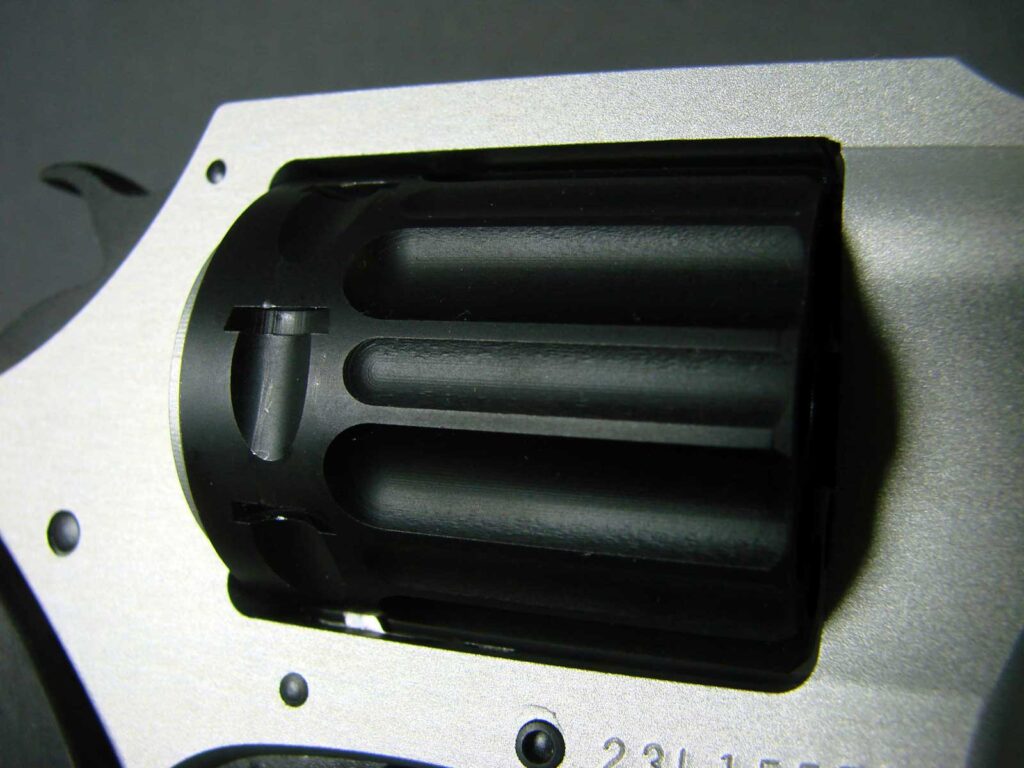
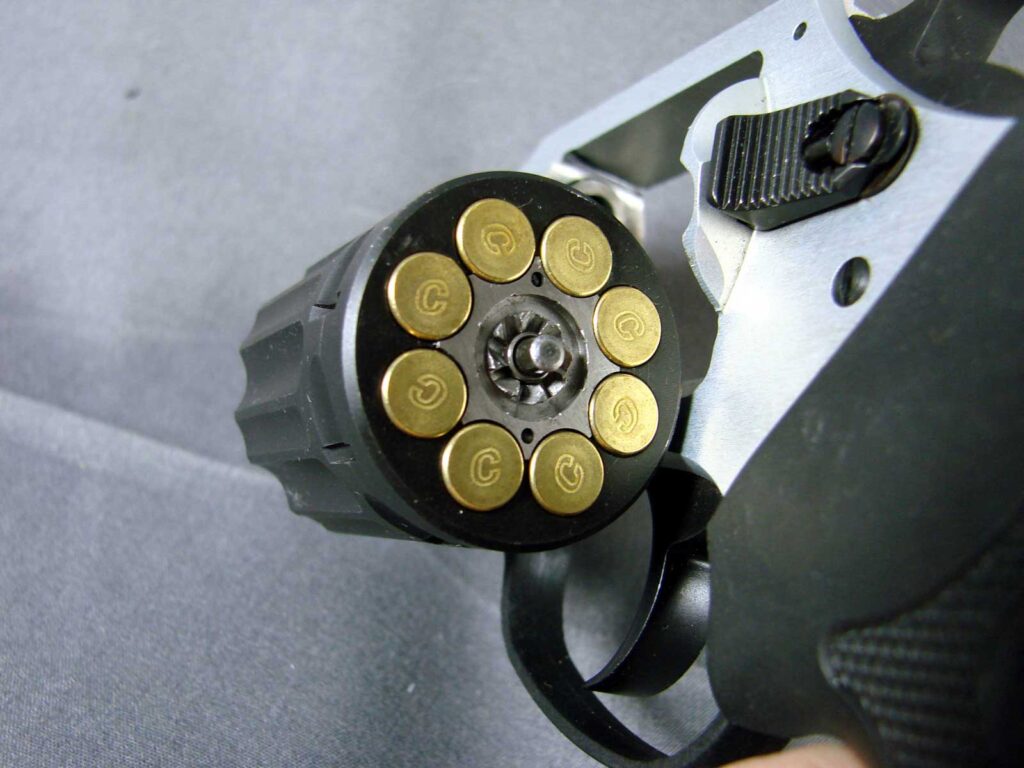
Eight-shot “Double Fluted” cylinder
Those who scoff at the use of small revolvers for self-defensive purposes tend to downright snort at the idea of using a 22-caliber. While I would not recommend a 22 Long Rifle be used for self-defense, I do recognize that even the 22 LR is substantially more effective than harsh language or fingernails. Many examples can be found of Good Guys using a 22 LR to thwart Bad Guys, but that does not make the 22 LR the first, or even the fifth choice, of defensive calibers.
The 22 Magnum, in my opinion, is quite another matter. I myself have, on numerous occasions and under certain conditions, carried 22 Magnum revolvers for defensive purposes. The 22 Magnum can be expected to propel a 40-to-50-grain bullet to about 2000 feet per second (fps) using a 24-inch test barrel, making about 300-350 foot-pounds (ft-lb) of energy at the muzzle. This is quite impressive, but of course the short two-inch barrel of the Pathfinder Lite means that a good deal of gunpowder is burned after Elvis has left the building, and my chronograph testing has shown that muzzle speed can be expected to diminish by 50 percent from rifle-fired laboratory numbers. Even taking this into consideration, however, the 22 Magnum still retains enough velocity to achieve reliable bullet expansion, and can be quite effective as a defensive cartridge. I have witnessed ballistic gelatin testing showing that the 22 Magnum, given the right bullet selection, can exhibit consistent bullet expansion, and can also out-penetrate many 38 Special loads.
Another thing the 22 Magnum has going for it is lack of recoil, which is a major advantage for those aforementioned many less-experienced shooters who are entering the self-defense handgun marketplace. I often recommend the 22 Magnum to novice shooters for this reason, as it takes a certain amount of seasoning for a shooter to become impervious to (or at least, resistant to) the effects of recoil. When my girlfriend (who later became my Bride) expressed a desire for a self-defense handgun of her own, I bought her a 22 Magnum revolver; as I loved her then and now, I would not have done this if I wasn’t confident in her ability to use it effectively, and the 22 Magnum’s ability to do its part. Similarly, those who are recoil-sensitive for other reasons, such as age or infirmity, are well-served with the 22 Magnum revolver.
As mentioned, the Charter Arms Pathfinder Lite #52329 weighs a scant 16 ounces, making it effortless to carry, and its small size makes it easy to conceal in a pocket, on a belt, or in a handbag. This light weight is obtained by the use of anodized aircraft-grade aluminum for the main frame, and modern polymer for the grip frame / trigger guard. All other major components (cylinder, barrel, hammer, trigger, pins, and internal action parts) are steel; only these non-stress components are made from lighter materials, resulting in a sturdy, strong, and lightweight revolver. The clear (gray) anodized main frame makes a pleasing visual contrast with the remainder of the revolver, which is finished in black.
The Pathfinder Lite’s steel barrel is finished in black, and features a full underlug to completely protect the ejector rod. The muzzle has a very nice recessed crown, which is aesthetically pleasing as well as adding protection to the muzzle end of the bore.
The Pathfinder Lite’s steel cylinder is finished in black, and is of an eight-shot capacity. This constitutes another marked advantage for the Pathfinder Lite over most small-frame revolvers: the familiar small-frame (“J-Frame”) 38 Special revolver typically holds five cartridges, which gives the Pathfinder Lite a 60% advantage in cylinder capacity over the J-Frame 38. The Pathfinder Lite’s steel cylinder is also “double fluted”, which shaves a bit more weight from the total, and is quite pleasing to the eye.
The grip panels are soft rubber, checkered and finger-grooved , and the full-sized grip makes the Pathfinder Lite much easier to control under recoil (which is the only kind of “gun control” that should ever be at issue). These grip panels add very little bulk to the Pathfinder Lite, and are not an impediment to concealment, but there are many options for replacement grips available from numerous grip makers should the shooter desire a change. Charter Arms’ Online Store offers a good selection of grips in several different sizes and materials, including the excellent Crimson Trace® Laser Grip.
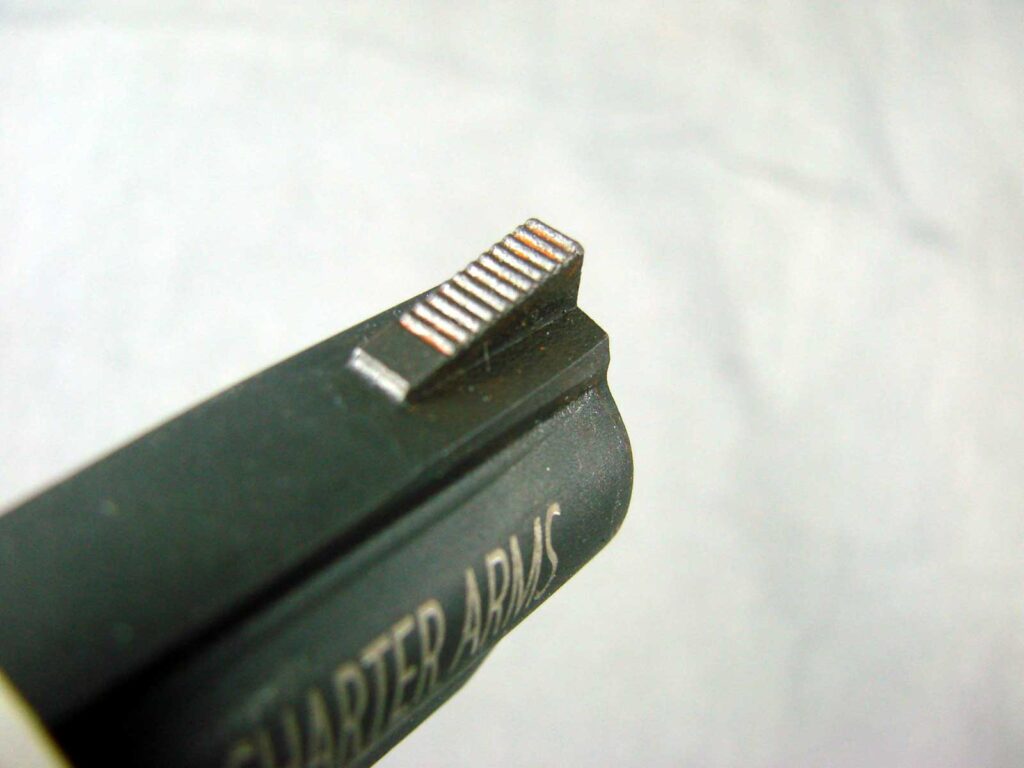
Ramp front sight is integral to the barrel
The sights on the Pathfinder Lite will be familiar to those acquainted with Charter Arms products, or other similar J-Frame type revolvers. The front sight is machined integral to the barrel, configured as a gentle ramp, and finely grooved to reduce glare in bright lighting conditions. The rear sight is a corresponding groove in the top of the frame. The contrast of the black front sight blade and the gray anodized rear sight groove makes the front sight very quick and easy to acquire in all but the dimmest ambient light. The sights are fixed, not adjustable, so different loads will shoot to slightly different points of aim. It is important to practice with your chosen load, and to tailor the loads chosen to the point of impact; once this is established, such fixed sights will never go out of adjustment.
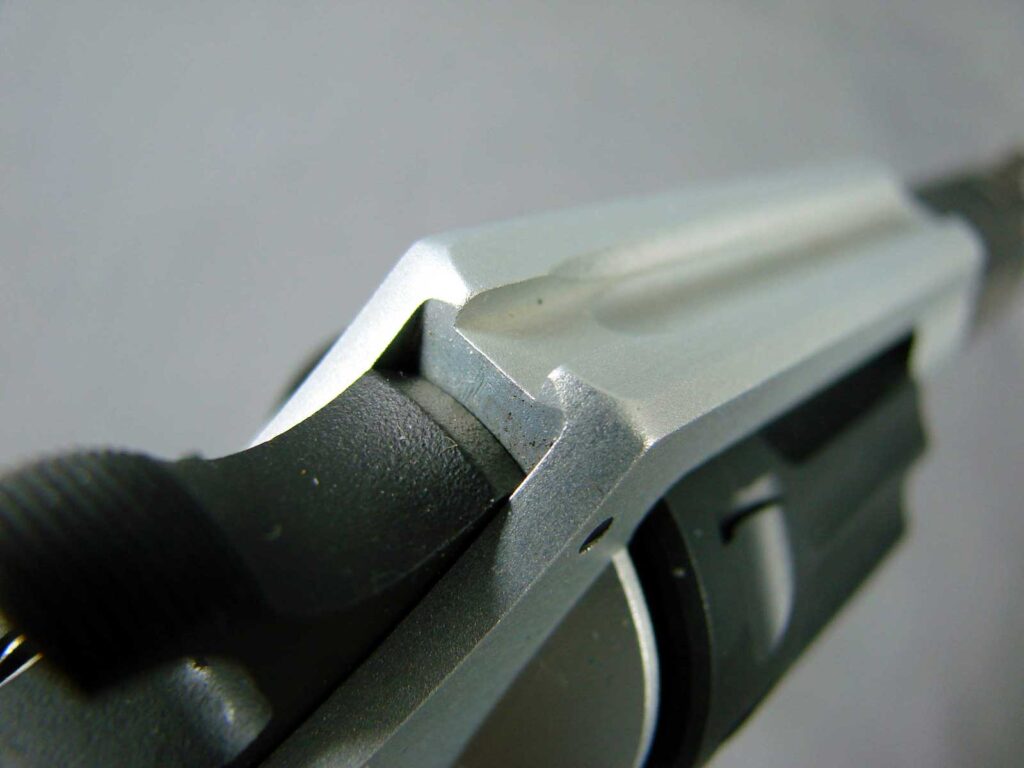
Rear sight is a simple groove in the top of the frame
The hammer and trigger are steel, finished in black. The hammer is of the standard spur configuration, allowing the Pathfinder Lite to be effectively used in Single-Action or Double-Action modes. For the uninitiated, Double-Action means that the trigger accomplishes two actions (cocking and releasing the hammer), and Single-Action means that the trigger accomplishes only one action (releasing the hammer after the hammer is manually cocked). The Pathfinder Lite’s hammer is finely grooved to aid in Single-Action shooting, while the trigger is nicely curved and smooth, with no sharp edges, which greatly aids in Double-Action shooting. The trigger pull is amazing, just short of miraculous; for those who are familiar with Double-Action rimfire revolvers, you already know that the trigger pulls tend to be horrendous. Since the rim of the cartridge must be struck with significant force to reliably ignite the primer compound contained within the rim of the cartridge, hammer springs typically must be powerful, and therefore exhibit a great deal of resistance. It is not at all unusual to see Double-Action pulls of over twelve pounds in such revolvers, with Single-Action trigger pull weights well over half that; it is not hard to imagine how difficult it can be to achieve any acceptable level of accuracy using a one-pound revolver with a twelve-pound trigger pull. Such trigger pull weights, which were always considered to be a mechanical necessity, are the main reason why many shooters do not believe small-frame rimfire revolvers to be accurate as a rule. I was expecting such a monstrous trigger pull from this Pathfinder Lite, but was surprised and delighted to discover that the Double-Action trigger pull measured only 6 pounds, 8.4 ounces on average, with a corresponding average Single-Action trigger pull measuring only 1 pound, 11.6 ounces. In fact, although I was impressed by the smooth action of the Pathfinder Lite, I found it hard to believe my initial readings using a Lyman Electronic Digital Trigger Pull Gauge, so I confirmed them using a ConcealedCarry.com Digital Trigger Pull Gauge. Not only were the low trigger pull numbers accurate, but never in any of my testing, using a wide variety of ammunition, was there a single misfire or failure of any kind.
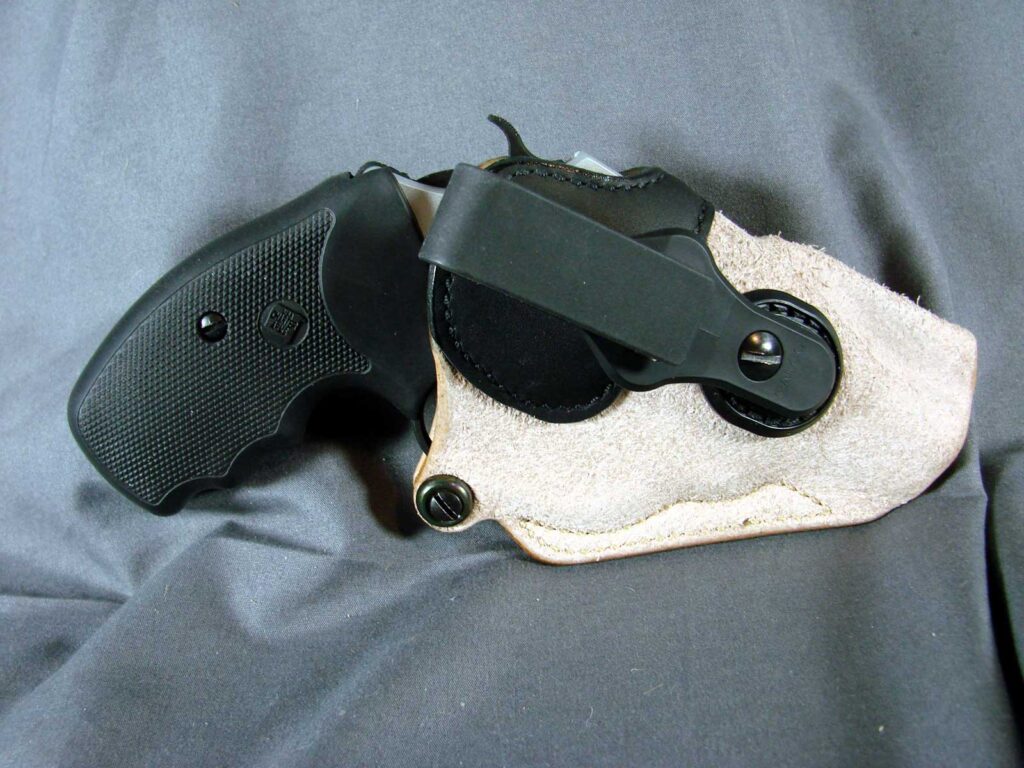
Galco® Scout 3.0 Strongside / Crossdraw IWB Holster
SPECS – Charter Arms Pathfinder Lite
Model: 52329
Type: Revolver, Single / Double Action
Capacity: 8 Shots
Caliber: 22 Magnum (22 WMR)
Weight: 16 Ounces
Finish: Black/Anodized
Frame: Aluminum
Barrel: Steel, 2 Inches, Full Underlug, Black Finish
Cylinder: Steel, Double Fluted, Black Finish
Grip: Full Size, Checkered Rubber with Finger Grooves
Hammer: Standard
Safety: Automatic Transfer Bar
Trigger: Curved, Smooth, Black Finish
Trigger Pull, Double-Action: 6 Pounds, 8.4 Ounces
Trigger Pull, Single-Action: 1 Pound, 11.6 Ounces
Accessories Included: Lockable Hard Plastic Case, Manual, Trigger Lock, Plastic Snap Caps
MSRP as of January 2025: $420.00 US
Shooting the Pathfinder Lite was a pleasure. The little revolver handled perfectly, was easy to shoot, and easy to shoot well. Accuracy was more than acceptable: firing standing offhand at typical “social work” distance (5 yards, or 15 feet), using a variety of ammunition types, keeping five shots within one to two inches was easily accomplished. The Pathfinder Lite proved to be 100% reliable, fun to shoot, and plenty accurate for any purpose to which it may be put, whether that purpose be fun/plinking, as a “kit gun”, or for self-defense.
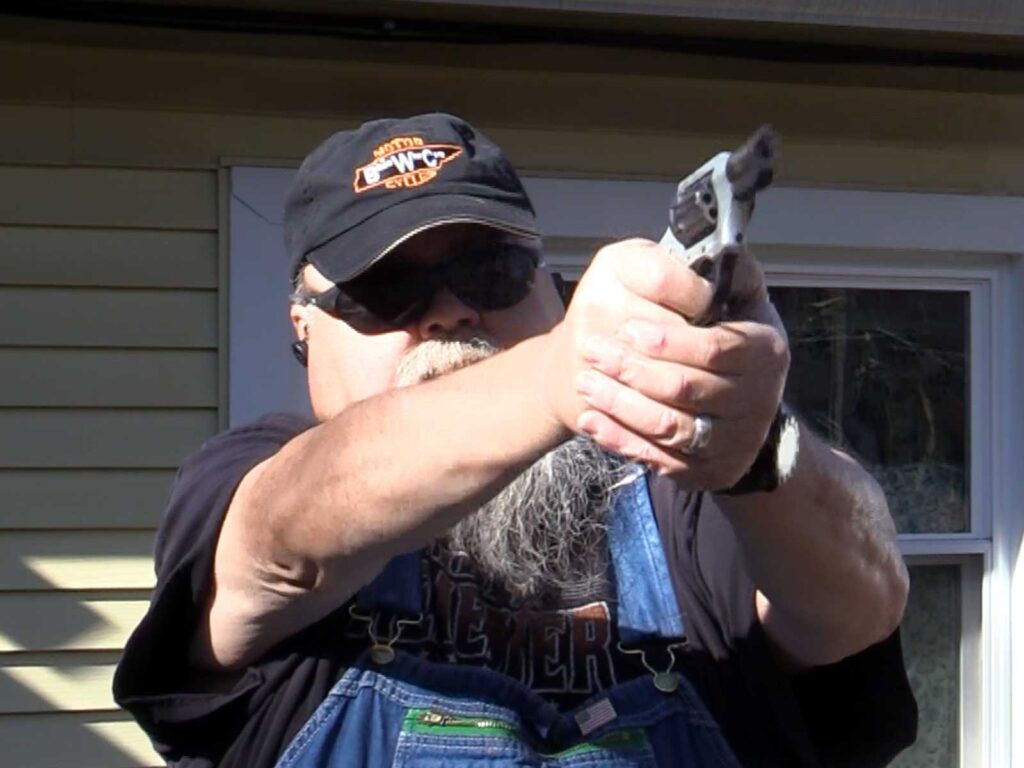
Boge shoots the Charter Pathfinder Lite 22 Magnum
If you are like me, you already own a number of J-Frame revolvers, and probably have a few J-Frame holsters lying about; the Pathfinder Lite does fit a standard J-Frame holster, making it even more useful. For concealed carry, I have come to favor IWB (Inside the Waist Band) holsters. Even though I wear bib overalls almost all of the time, and thus seldom wear a belt, I find that a well-designed IWB holster will nestle perfectly into the side of the bib on the strong side, and I often carry in that manner. The Galco Scout 3.0 Strong Side / Crossdraw IWB Holster (Item #S2-158B) is perfect for such application: made from rough-out steerhide, the Scout 3.0 is easily configured for right-hand or left-hand use. The open top is reinforced for easy holstering. Tension is easily adjustable, as is the cant. There are two belt clips included: the UniClip fits belts of up to 1-3/4″, while the Ultimate Stealth Clips fits belts of unlimited width. I find that the UniClip works perfectly clipped into the side of my overalls, but depending on the type of belt I might wish to wear, the Ultimate Stealth Clip is a nice option to have. The Galco Scout 3.0 sells for $115.00 directly from Galco Holsters.
Most often, when I carry a J-Frame revolver (or a small semi-auto pistol), I carry it in my pocket. Pocket carry is a great carry mode, but many people who pocket carry do it wrong: that is, many do not use a pocket holster. In the past, I carried without a pocket holster, but my dear departed friend Ed Head, who was a noted instructor at Gunsite Academy in Arizona, changed my thinking in that regard years ago. It is important to use a pocket holster for two reasons: firstly, a pocket holster breaks-up the outline of the handgun, making it less obvious that you are carrying (after all, if one is carrying concealed, it is better to have the handgun actually concealed); secondly, and most importantly, a pocket holster allows the handgun to present itself consistently, instead of rolling and flopping around in the pocket until the butt is in a different place every time you reach for it. Such an inconsistent presentation can actually cost you your life; if you need your handgun, you need it NOW, and you probably will not have the few seconds it will take to find the butt of the handgun and wrestle it out of your pocket. Galco’s Front Pocket Horsehide Holster (model #PH158) is perfect for this. Made from premium horsehide, the Front Pocket Holster is smooth inside for ease of drawing, and rough on the outside to retain the holster inside your pocket on the draw. The holster is designed with a double hooked shape to further aid with retention in the pocket; this is very important, as it could be fatally embarrassing to have to take extra time to pluck the holster off of the gun after the draw. The Galco Front Pocket Horsehide Holster is obviously designed for front-pocket use, but it works equally well for back-pocket carry; I used to carry in my front pocket, but (again, thanks to Ed Head’s sage advice) switched to the back pocket because it works better for me, as it is MUCH faster for me to draw from the back pocket when in a seated position. Whether used in the front pocket or the back pocket, Galco’s Front Pocket Horsehide Holster is perfect, and it sells for $94.00 direct from Galco.

5-yard (15 feet) accuracy, fired standing offhand single-action. The Charter Pathfinder is plenty accurate, and the Hornady® Critical Defense® 45-Grain FTX® load is a fine choice for both accuracy and bullet performance.
As Charter Arms enters its seventh decade of existence, they are making the best products they have ever offered. Modern manufacturing techniques, along with major investments in the latest computerized equipment, have allowed Charter Arms to significantly upgrade their fit and finish, maximize design, and minimize cost, while maintaining their reputation as a leader in value. The Pathfinder Lite is 100% Made in the USA, and retails for only $420.00 US, which is less than half the retail price of similar models from other makers. The lightweight (16-ounce), aluminum-framed Pathfinder Lite offers an eight-shot capacity of 22 Magnum, in a package the same size as small-framed 38 Special revolvers, which typically hold 5 rounds. The 22 Magnum is a viable defensive cartridge, and the 60% capacity advantage over the 38 Special can make all the difference.
To locate a dealer near you visit www.lipseys.com/dealerfinder
